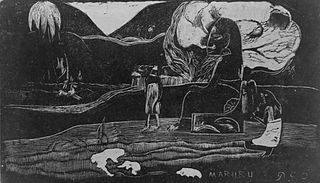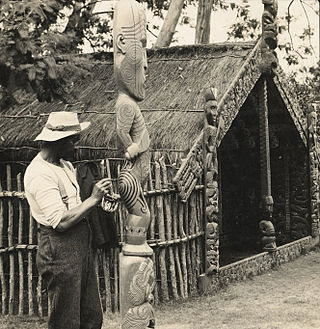Related Research Articles
Māui or Maui is the great culture hero and trickster in Polynesian mythology. Very rarely was Māui actually worshipped, being less of a deity (Demigod) and more of a folk hero. His origins vary from culture to culture, but many of his main exploits remain relatively similar.

Hina is the name assigned to a number of Polynesian deities. The name Hina usually relates to a powerful female force who has dominion over a specific entity. Some variations of the name Hina include Sina, Hanaiakamalama, and Ina. Even within a single culture, Hina could refer to multiple goddesses and the distinction between the different identities are not always clear. In Hawaiian mythology, the name is usually paired with words which explain or identify the goddess and her power such as Hina-puku-iʻa (Hina-gathering-seafood) the goddess of fishermen, and Hina-ʻopu-hala-koʻa who gave birth to all reef life.

In Māori mythology, Rehua is a very sacred personage, who lives in Te Putahi-nui-o-Rehua in Rangi-tuarea, the tenth and highest of the heavens in some versions of Māori lore. Rehua is identified with certain stars. To the Tūhoe people of the North Island he is Antares. Others say he is Betelgeuse, or Sirius. Because he lives in the highest of the skies, Rehua is untouched by death, and has the power to cure blindness, revive the dead, and heal any disease. He is a son of Rangi and Papa, and the father of Kaitangata, as well as the ancestor of Māui. A Ngāi Tahu legend from the South Island speaks of Rehua as the eldest son of Rangi and Papa, who first manifested as lightning, but assumed a human shape when he travelled into the skies. Later his brother Tāne went to pay him a visit, Rehua had birds in his hair, feeding on his lice. Rehua had his servants cook and prepare the birds as a meal for Tāne, who was shocked and declined to eat them because the birds had eaten the lice from Rehua's head, which was extremely tapu (sacred). However Rehua gave him birds to bring down to this world, and showed him how to snare them. Tāne also brought with him the fruit trees that the birds fed on, and so it is that there are forests and birds on the earth.
Tangaroa is the great atua of the sea, lakes, rivers, and creatures that live within them, especially fish, in Māori mythology. As Tangaroa-whakamau-tai he exercises control over the tides. He is sometimes depicted as a whale.

Hine-nui-te-pō in Māori legends, is a goddess of night and she receives the spirits of humans when they die. She is the daughter of Tāne Mahuta / Tāne Tuturi and Hine-ahuone. It is believed among Māori that the colour red in the sky comes from her. Hine-nui-te-pō shepherds the wairua/souls into the first level of Rarohenga to ready them for the next stage of their journey. Before she was hine-nui-te-po her name was Hine-ti-tama. Her father Tane mahuta took her virginity; she then felt ashamed, hiding herself in internal darkness to hide from her father and became Hine-nui-te-po goddess of the night.
In a tradition of the Moriori people of the Chatham Islands, Rohe is the wife of the demi-god Māui. Beautiful Rohe was a sister of the sun, and her face shone. A quarrel arose after Rohe remarked that Māui's face was ugly. Māui then decided that they should change faces.
In Māori mythology, Taranga is the mother of Māui. Her husband is Makeatutara. Māui was born prematurely, so Taranga wrapped his body in her hair and threw him into the waves. Some sea-creatures cared for him, hiding him in kelp until a storm sent him back to the beach. His ancestor, Tama-nui-a-rangi, found him and brought him back to life, and educated him.

In Polynesian mythology, stories about Tinirau are found throughout the islands of Polynesia. He is a guardian of fish. Many themes recur in the various versions. Often he travels to another land in search of his wife, or his wife travels to another land in search of him; sometimes he treats his wife badly, or she rejects him; while he is guardian of fish, it is his wife who gives the fish their individual characteristics. Sometimes their anxious or jealous relatives try to separate the lovers.
Takatāpui is a Māori language term that is used in a similar way to LGBT. When speaking Māori, LGBT people of any culture are referred to as takatāpui. In English, a takatāpui person is a Māori individual who is gay, lesbian, bisexual, or transgender (LGBT).

In Māori mythology, Tinirau is a guardian of fish. He is a son of Tangaroa, the god of the sea. His home at Motutapu is surrounded with pools for breeding fish. He also has several pet whales.

In Māori mythology, Tiki is the first man created by either Tūmatauenga or Tāne. He found the first woman, Marikoriko, in a pond; she seduced him and he became the father of Hine-kau-ataata. By extension, a tiki is a large or small wooden, pounamu or stone carving in humanoid form, notably worn on the neck as a hei-tiki, although this is a somewhat archaic usage in the Māori language. Hei-tiki are often considered taonga, especially if they are older and have been passed down throughout multiple generations. Carvings similar to ngā tiki and coming to represent deified ancestors are found in most Polynesian cultures. They often serve to mark the boundaries of sacred or significant sites. In the Western world, Tiki culture, a movement inspired by various Pacific cultures, has become popular in the 20th and 21st centuries; this has proven controversial, however, as the movement is regarded by many Polynesians as cultural appropriation.
Rarohenga is the subterranean realm where spirits of the deceased dwell after death, according to Māori oral tradition. The underworld is ruled by Hine-nui-te-pō, the goddess of death and night. Additional occupants include guardians, gods, goddesses, holy chiefs and nobles (rangatira), and the tūrehu, who are described as celestial, fairy-like people. Rarohenga is predominantly depicted as a place of peace and light. As articulated by Māori ethnographer Elsdon Best: It is a place where darkness is unknown. "This is the reason why, of all spirits of the dead since the time of Hine-ahuone…, not a single one has ever returned hither to dwell in this world".

Māori mythology and Māori traditions are two major categories into which the remote oral history of New Zealand's Māori may be divided. Māori myths concern fantastic tales relating to the origins of what was the observable world for the pre-European Māori, often involving gods and demigods. Māori tradition concerns more folkloric legends often involving historical or semi-historical forebears. Both categories merge in whakapapa to explain the overall origin of the Māori and their connections to the world which they lived in.
In Māori mythology, as in other Polynesian traditions, Māui is a culture hero and a trickster, famous for his exploits and cleverness. He possessed superhuman strength, and was capable of shapeshifting into animals such as birds and worms.

In Hawaiian religion, Māui is a culture hero and ancient chief who appears in several different genealogies. In the Kumulipo, he is the son of ʻAkalana and his wife Hina-a-ke-ahi (Hina). This couple has four sons, Māui-mua, Māui-waena, Māui-kiʻikiʻi, and Māui-a-kalana. Māui-a-kalana's wife is named Hinakealohaila, and his son is named Nanamaoa. Māui is one of the Kupua. His name is the same as that of the Hawaiian island Maui, although native tradition holds that it is not named for him directly, but instead named after the son of Hawaii's discoverer.
In Māori mythology, Hinauri is the sister of Māui and the wife of Irawaru. Māui becomes annoyed with Irawaru and stretches out his limbs, turning him into a dog. When Hinauri asks Māui if he has seen her husband, Māui tells her to call “Moi! Moi!” whereupon the poor dog runs up, and Hinauri, learning the truth, throws herself into the sea.
Uenuku is an atua of rainbows and a prominent ancestor in Māori tradition. Māori believed that the rainbow's appearance represented an omen, and one kind of yearly offering made to him was that of the young leaves of the first planted kūmara crop. He was a tribal war god invoked before battles, particularly in the northern half of the country. It was said that if a taua appeared under the arch of the rainbow, it would be defeated in battle, and likewise, if they appeared to either side of the rainbow, they would be victorious. The Māori identified hawk feathers and a particular star called Uenuku as being sacred to him.

Kurī is the Māori name for the extinct Polynesian dog. It was introduced to New Zealand by the Polynesian ancestors of the Māori during their migration from East Polynesia in the 13th century AD. According to Māori tradition, the demigod Māui transformed his brother-in-law Irawaru into the first dog.

Māori traditional textiles are the indigenous textiles of the Māori people of New Zealand. The organisation Te Roopu Raranga Whatu o Aotearoa, the national Māori weavers' collective, aims to preserve and foster the skills of making and using these materials.
Toi-te-huatahi, also known as Toi and Toi-kai-rākau, is a legendary Māori tupuna (ancestor) of many Māori iwi (tribes) from the Bay of Plenty area, including Ngāti Awa, Ngāi Te Rangi and Ngāi Tūhoe. The Bay of Plenty's name in te reo Māori, Te Moana-a-Toi, references Toi-te-huatahi.
References
- E.R. Tregear, Maori-Polynesian Comparative Dictionary (Lyon and Blair: Lambton Quay, 1891).
- C. Tremewan, Traditional Stories from Southern New Zealand: He Kōrero nō Te Wai Pounamu (Macmillan Brown Centre for Pacific Studies: Christchurch), 2002.